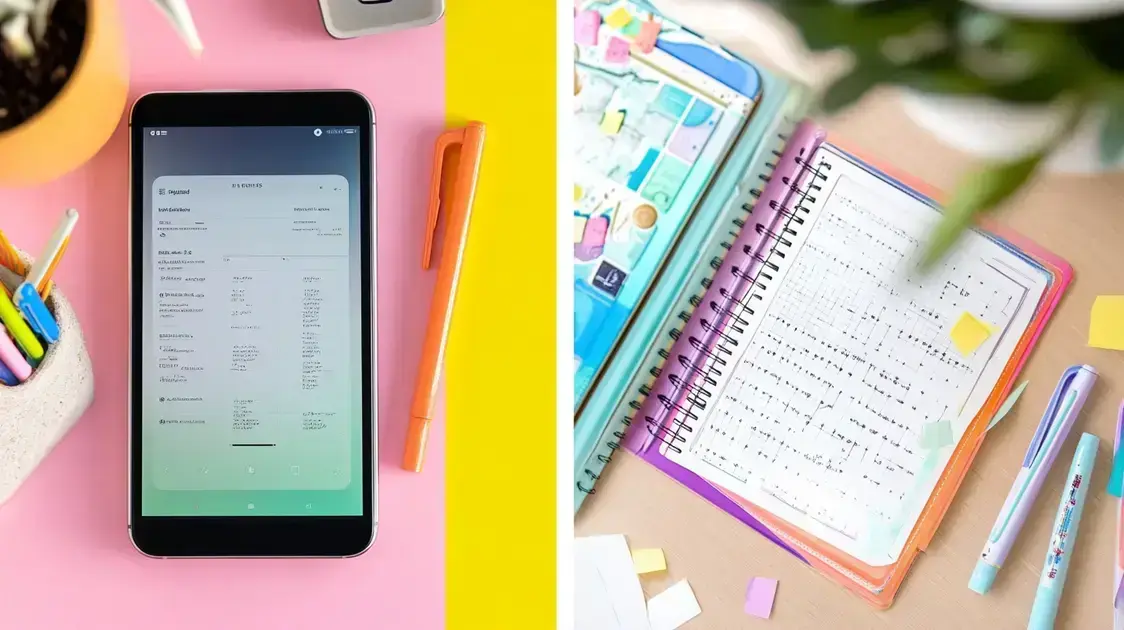Are you overwhelmed by tasks or struggling with organization? Finding the best productivity planners can change your life.
These tools offer structure, streamline your schedule, and set you on the path to success.
In this post, we will delve into choosing the right planner, expert tips, and strategies to maximize efficiency in your daily routine.
Top Features of the Best Productivity Planners
When it comes to choosing the best productivity planners, understanding their top features is crucial. These features ensure effective time management, goal tracking, and organization, enabling you to reach your full potential. Here’s a breakdown of must-have functionalities:
Customizable Layouts
A great planner should offer customizable layouts, such as daily, weekly, or monthly spreads, catering to different planning styles and personal preferences.
Goal-Setting Templates
Look for planners that include goal-setting templates to help you create actionable plans. These pages keep your short-term and long-term objectives visible and attainable.
Habit Trackers
Many best productivity planners feature habit trackers. These tools help monitor and reinforce positive habits like exercising, reading, or meditating daily.
Ample Writing Space
Ample space for writing is essential. Planners that allocate enough room for detailed planning and journaling enhance their practicality and usability.
Integration with Other Tools
Some modern planners provide integrations with apps or other tools, allowing you to sync schedules, set reminders, or back up important notes.
Durable Design
Durability matters, especially if you’ll carry your planner everywhere. Spiral bindings, high-quality paper, and sturdy covers are distinguishing features of long-lasting planners.
Inspirational Quotes
For a motivational boost, some planners include inspirational quotes or affirmations to keep you positive and focused throughout your journey.
By ensuring these features are present, you’ll choose a productivity planner that becomes a reliable companion in your quest for success.
How to Choose the Right Planner for Your Needs
Choosing the right planner for your needs requires understanding your lifestyle, goals, and preferences. A well-suited planner should align with your specific requirements while enhancing productivity.
Identify Your Purpose
Determine why you need a planner. Is it for work, school, personal goals, or a combination? Knowing your purpose ensures you select a planner tailored to your priorities.
Consider Your Planning Style
Everyone plans differently. If you prefer detailed scheduling, choose a planner with hourly breakdowns. For a broad overview, weekly or monthly layouts may work better.
Choose Between Digital and Paper
Decide if a digital or paper planner suits you. Digital planners offer flexibility and portability, while paper planners provide a tactile experience and simplicity.
Evaluate Size and Portability
If you’re always on the go, a compact and lightweight planner is ideal. For desktop use, a larger, more detailed planner might be better.
Assess Features
Check for features like goal-setting pages, habit trackers, budget sections, or space for notes. These extras add value and functionality.
Think About Aesthetics
The design and style of a planner can impact how likely you are to use it. Choose a planner with a look that resonates with you, boosting motivation to stay consistent.
Trial Before Commitment
Some planners offer downloadable samples or digital previews. Experimenting with these helps you understand if the layout and features fit your needs before purchasing.
By following these considerations, you can ensure your productivity planner becomes an effective tool that supports your goals and enhances your productivity.
Digital vs. Paper Productivity Planners

Choosing between digital and paper productivity planners can be challenging, as both options have unique benefits and appeal to different preferences. Understanding their key differences can help you select the best fit for your lifestyle and needs.
Digital Planners
Digital planners offer unparalleled convenience and flexibility. They are accessible through smartphones, tablets, or computers, making it easy to update your schedule on the go.
Popular features include automated reminders, search functionality, and synchronization across devices. Additionally, they reduce paper use, making them an eco-friendly choice.
Apps like Notion, Google Calendar, and Trello are common examples that blend planning with task management.
Paper Planners
For those who appreciate a tactile experience, paper planners are a classic choice. They provide a distraction-free way to organize your thoughts and plans without the presence of notifications or device-dependent tools.
Writing by hand can also aid in memory retention, helping you stay more engaged with your daily schedule. Many options include customizable layouts, artistic designs, and space for creativity like doodling or journaling.
Key Considerations
Portability: Digital planners are more compact since they are stored on devices, while paper planners may take up physical space.
Durability: Paper planners can be vulnerable to wear and tear, while digital ones depend on devices and charging.
Customization: Digital options often allow unlimited edits, templates, and integration with other tools, whereas paper planners are visually unique and more personalized through handwriting.
Offline Access: While paper planners require no tech, limited digital planners offer offline availability.
By weighing the benefits and limitations of both formats, you can choose the one that complements your organizational style and planning goals.
Best Productivity Planners for Entrepreneurs
Entrepreneurs require planners that cater specifically to their dynamic and demanding schedules. The right productivity planner not only keeps priorities in check but also helps manage goals, meetings, and to-do lists effectively.
Here are some of the best productivity planners for entrepreneurs:
1. Full Focus Planner
The Full Focus Planner is designed for goal-oriented individuals. It emphasizes prioritization by focusing on daily Big Three goals and includes quarterly and annual goal-tracking sections.
2. Panda Planner
The Panda Planner offers a structured framework for time management. It includes sections for gratitude, focus, daily priorities, and reflection, promoting both productivity and mindfulness.
3. The SELF Journal
The SELF Journal is perfect for entrepreneurs working on specific projects. It features a 13-week goal system, daily scheduling, and space to document accomplishments and lessons learned.
4. Passion Planner
The Passion Planner is ideal for those balancing life and work goals. Its mind-mapping section helps visualize progress, while the monthly reflection pages encourage self-improvement.
5. Clever Fox Planner
The Clever Fox Planner combines goal-setting tools with habit trackers and budget planning, making it versatile for entrepreneurs managing multiple aspects of their lives.
6. Moleskine Professional Planner
The Moleskine Professional Planner boasts a simple yet functional layout. Perfect for meetings, it includes task management sections and dedicated space for note-taking and project tracking.
7. Action Day Planner
The Action Day Planner integrates project planning and daily task management. Its unique format connects long-term plans with actionable daily steps.
These planners offer features tailored to the fast-paced and goal-driven needs of entrepreneurs, allowing them to stay organized, focused, and productive throughout their journey.
Best Productivity Planners for Students
Students require productivity planners designed to handle assignments, exams, and extracurricular activities while promoting effective time management. The best productivity planners for students combine structure with flexibility to help them stay organized and stress-free.
1. Academic Planner by Erin Condren
The Erin Condren Academic Planner is tailored to students’ needs, featuring dated weekly and monthly layouts, sections for tracking deadlines, projects, and exams, plus colorful and motivational designs.
2. The Class Tracker
The Class Tracker is specifically created for high school and college students. It helps manage class schedules, assignments, and extracurricular activities with space for weekly and daily to-do lists.
3. Passion Planner
The Passion Planner is great for students balancing academics and personal development. It offers goal-setting sections, reflection pages, and undated layouts for personalized planning.
4. Panda Planner Academic
The Panda Planner Academic incorporates features for self-reflection and productivity, including gratitude prompts, a weekly review, and sections for tracking class goals.
5. Moleskine Student Life Planner
Moleskine’s Student Life Planner combines elegant design with functionality, featuring annual, monthly, and weekly layouts tailored for exams, lectures, and assignment tracking.
6. Smart Planner Pro
The Smart Planner Pro targets students who prefer structured planning. Its dated weekly layout, habit tracker, and goal-setting pages are ideal for staying organized.
7. Blue Sky Academic Planner
The Blue Sky Academic Planner is user-friendly and budget-friendly. It features clean layouts with dedicated areas for class schedules, notes, and monthly calendars.
These planners have been designed to support students in staying on top of their tasks while fostering productivity and academic success through organization and goal tracking.
Daily, Weekly, and Monthly Planning Explained

Effective planning involves organizing tasks and goals on different time scales, whether daily, weekly, or monthly. Each level serves a unique purpose and enhances overall productivity.
Daily Planning
Daily planning focuses on breaking down larger goals into actionable steps. It involves prioritizing tasks, setting specific time frames, and maintaining accountability. Most planners offer sections for to-do lists, schedules, and brief reflections for each day. This approach is ideal for managing immediate responsibilities and maximizing efficiency every day.
Benefits: Boosts focus, allows for detailed time tracking, and reduces the risk of overlooking important tasks.
Weekly Planning
Weekly planning bridges short-term activities and long-term goals. It’s perfect for visualizing commitments, managing priorities, and blocking time for key projects. This method helps identify trends, plan ahead, and maintain balance between work and personal life. Many planners include weekly spreads with sections for objectives, tasks, and reflection.
Benefits: Offers a broader perspective, simplifies scheduling recurring tasks, and provides flexibility while staying on track.
Monthly Planning
Monthly planning provides an overarching view of goals, deadlines, and events. It enables better alignment with long-term objectives by offering dedicated space to identify key milestones.
Most of the best productivity planners feature monthly calendars or grids to track events, appointments, and progress over time.
Benefits: Helps with goal setting, improves time management for larger projects, and ensures consistency in achieving milestones.
Utilizing a combination of daily, weekly, and monthly planning ensures that tasks are well-organized, goals are met efficiently, and time is effectively managed across all aspects of life.
How Productivity Planners Boost Efficiency
The best productivity planners are powerful tools for improving efficiency by organizing tasks, setting priorities, and maintaining focus. They provide a structured framework to manage time effectively and achieve goals without feeling overwhelmed.
Task Prioritization
Productivity planners help users to identify and prioritize tasks. By categorizing tasks based on urgency and importance, planners ensure that the most critical objectives receive attention first, minimizing procrastination.
Clarity and Focus
Planners create visual clarity of schedules and objectives, breaking larger goals into smaller, actionable tasks. This focus prevents distractions and keeps day-to-day progress aligned with long-term goals.
Time Management
Strong time management is enabled by planners through scheduled blocks of time, ensuring productivity throughout the day. Time-tracking sections also provide insight into where efforts are being allocated.
Habits and Routine Building
Many planners include habit trackers, helping encourage consistency and accountability when developing productive routines. Daily repetition fosters efficiency in completing tasks faster and more effectively.
Reduction of Stress
A well-organized planner acts as a mental relief by keeping all responsibilities documented in one place. This reduces stress by preventing missed deadlines, forgotten tasks, or last-minute rushes.
Goal Setting
Planners promote the development of meaningful short-term and long-term goals by including dedicated sections for tracking. These sections help ensure consistent progress and provide motivation as objectives are achieved.
Reflection and Improvement
With reflection pages featured in many planners, users can evaluate their performance, learn from challenges, and plan adjustments for the future. This ongoing improvement boosts long-term efficiency and success.
By implementing a productivity planner, individuals can take control of their schedules, work smarter, and accomplish more in less time, creating a greater sense of fulfillment and achievement.


